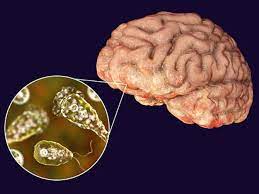Naegleria Fowleri : South Korea Reported First Case

South Korea reported its first case of the rare yet fatal infection – Naegleria fowleri or “brain-eating amoeba”.
Naegleria fowleri:
- It is a single-celled organism which can infect humans.
- It was first discovered in Australia in 1965 and is commonly found in warm freshwater bodies, such as hot springs, rivers and lakes.
- According to the US Centers for Disease Control and Prevention (CDC), with the rising global temperatures.
- The organism best grows in high temperatures up to 46°C and sometimes can survive at even higher temperatures.
- The amoeba enters the human body through the nose and then travels up to the brain. In some cases, it was found that people got infected when they cleaned their nostrils with contaminated water.
- Scientists haven’t found any evidence of the spreading of Naegleria fowleri through water vapour or aerosol droplets.
- Once Naegleria fowleri goes to the brain, it destroys brain tissues and causes a dangerous infection known as primary amebic meningoencephalitis (PAM).
- The first signs of PAM start showing within one to 12 days after the infection. In the initial stages, they might be similar to symptoms of meningitis, which are headache, nausea and fever.
- In the later stages, one can suffer from a stiff neck, seizures, hallucinations, and even coma.
- As the Naegleria fowleri infection is rare and progresses quickly, scientists haven’t been able to identify any effective treatments yet.




